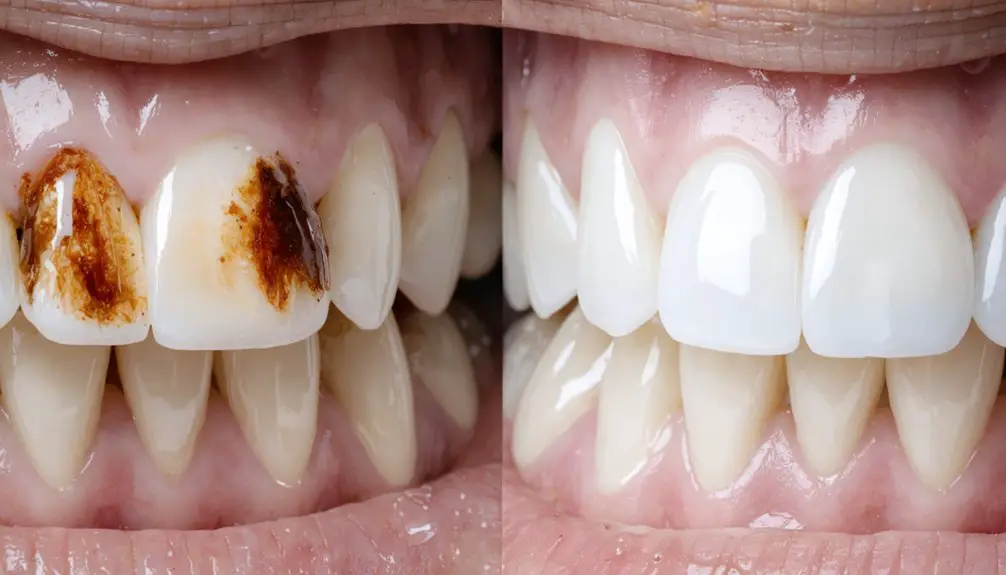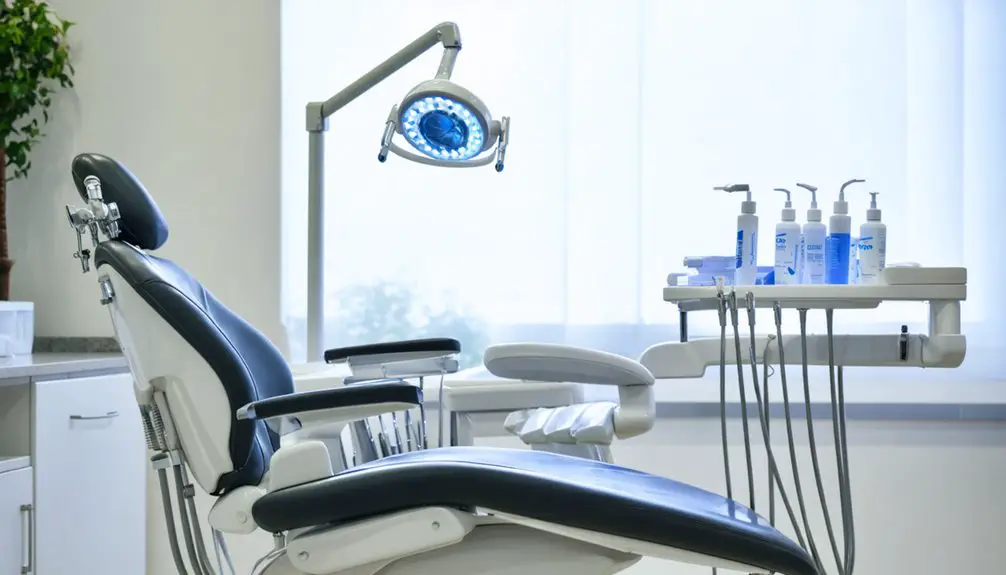You’ll find the most effective whitening solutions for tobacco-stained teeth through professional treatments like Philips Zoom or Opalescence Boost, which use concentrated peroxide gels for deep stain removal. In-office laser treatments and custom-fitted trays with professional-grade whitening agents can improve your smile by several shades. While at-home products offer maintenance support, professional intervention tackles both surface and internal discoloration. Discover how combining treatments with lifestyle changes can maximize your results.
Key Takeaways
- Professional in-office whitening treatments using concentrated peroxide gels offer the most effective results for removing tobacco stains in 30-60 minutes.
- Laser whitening treatments combined with high-concentration peroxide provide powerful stain removal when smokers quit for two weeks beforehand.
- Custom-fitted trays with 10% carbamide peroxide for at-home use can improve tooth color by four shades within a week.
- Deep bleaching methods using dual-peroxide formulas and LED activation effectively target stubborn tobacco stains under professional supervision.
- Regular professional cleanings every six months, combined with daily whitening toothpaste use, help maintain results and prevent stain buildup.
Understanding Tobacco Stains and Their Impact on Teeth
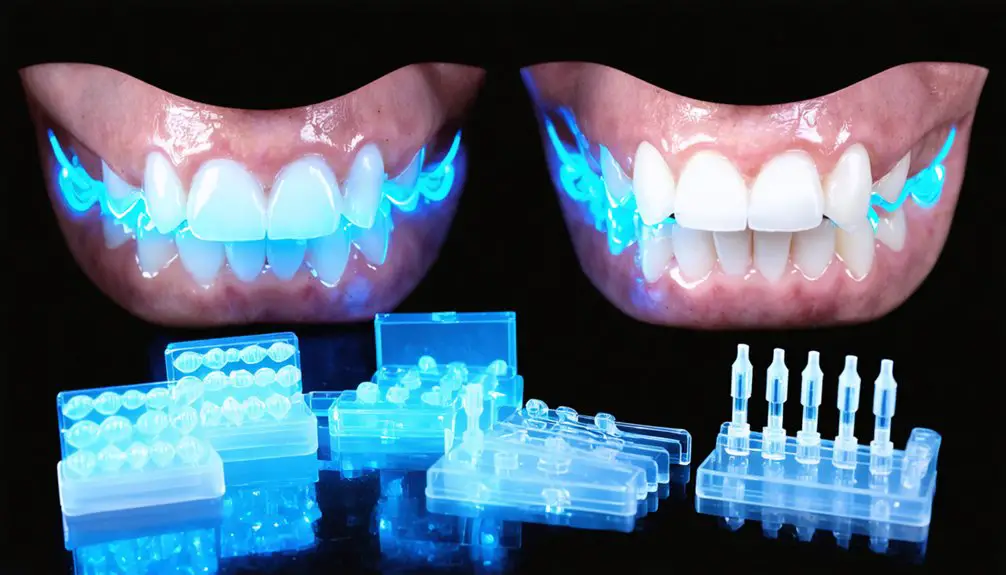
While tobacco use affects oral health in numerous ways, its impact on tooth appearance is often the most visible concern for smokers.
When you smoke, tar and nicotine work together to create stubborn stains on your teeth. Tar, a sticky substance, adheres to your tooth enamel, while nicotine, though initially colorless, turns yellow when exposed to air.
The double threat of smoking: tar clings to teeth while nicotine transforms from clear to yellow, permanently staining your smile.
The tobacco effects go beyond surface stains. These compounds can penetrate deep into your tooth structure, creating both extrinsic (surface) and intrinsic (internal) discoloration.
What makes stain removal particularly challenging is that smoking reduces saliva production, which normally helps cleanse your teeth. The combination of decreased saliva flow and sticky tar creates an environment where stains become more persistent and harder to remove, often requiring professional intervention for effective treatment.
Professional In-Office Whitening Solutions
When it comes to removing stubborn tobacco stains, professional in-office whitening treatments offer the most powerful and immediate solution available.
These in-office techniques use highly concentrated hydrogen peroxide or carbamide peroxide gels, expertly applied by dental professionals to guarantee both safety and peak whitening effectiveness.
You’ll find options like Philips Zoom, which combines powerful whitening agents with specialized light activation, or Opalescence Boost, which works without light.
Your dentist will first examine your oral health and clean your teeth to maximize results. The treatment typically takes 30-60 minutes, and you’ll notice several shades of improvement after just one session.
While results can last months, you’ll maintain the brightest results by following post-treatment care instructions and reducing tobacco use.
Laser Treatment Options for Severe Discoloration
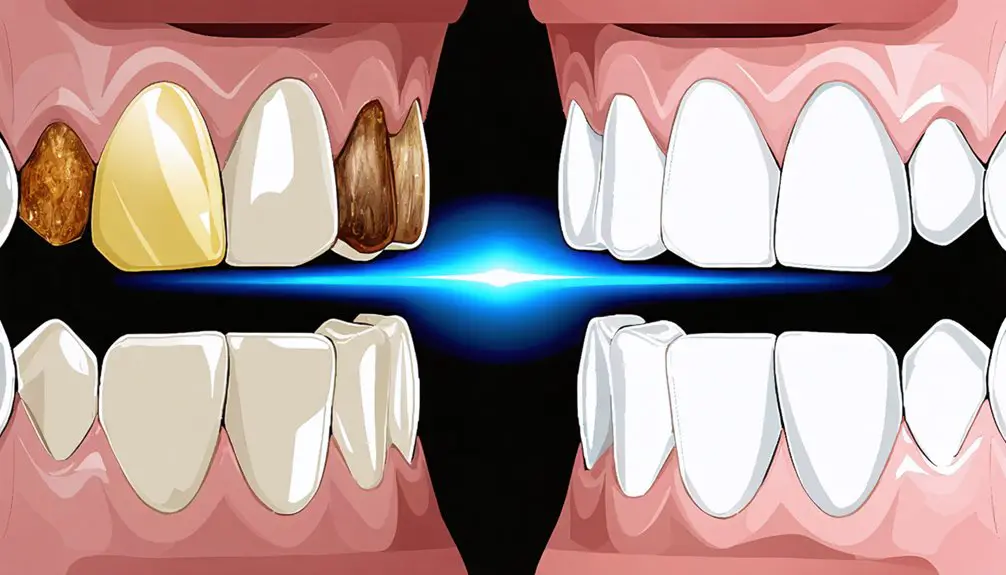
You’ll get the best results from laser whitening when you’ve quit smoking for at least two weeks before treatment, allowing your dentist to work with a clean surface.
The procedure involves your dentist applying a protective barrier to your gums, coating your teeth with high-concentration peroxide gel, and activating it with precise laser applications in 15-minute intervals.
For ideal outcomes, you should schedule your laser whitening session early in the day when you’re well-rested, as the treatment typically takes 30-60 minutes and requires you to keep your mouth open throughout the procedure.
Professional Laser Whitening Steps
Before undergoing professional laser whitening treatment, patients must complete a thorough pre-treatment examination to guarantee safety and ideal results.
Your dentist will assess your enamel health, review X-rays, and perform professional cleaning to remove plaque and tartar. The entire procedure takes about 60 minutes from start to finish. While not endorsed by major dental organizations, laser teeth whitening remains a popular cosmetic procedure.
During the laser whitening procedure, you’ll receive protective barriers for your gums and goggles for your eyes.
- Bleaching gel application takes 15-20 minutes, with careful placement to avoid soft tissue contact
- Dental laser activation accelerates stain removal through controlled heat application
- Treatment consists of three 15-minute sessions with monitoring breaks
- Post-treatment includes thorough gel removal and protective balm application
- You’ll receive specific aftercare instructions to maintain your results, including avoiding staining substances
For smokers with severe stains, laser whitening offers deeper penetration and more effective results when performed by qualified professionals.
Best Times For Treatment
To achieve ideal results from laser teeth whitening, smokers must carefully time their treatment around their tobacco use and oral health status.
You’ll need to wait at least one month after quitting smoking before starting treatment to allow your teeth to recover naturally. This timing factor helps reduce sensitivity risks and improves overall outcomes.
For severe tobacco stains, you’ll want to schedule your laser treatments after completing any necessary dental work and professional cleaning.
The treatment intervals typically involve 1-2 sessions, carefully spaced to monitor your enamel’s response.
Your dentist will assess your specific timing factors, including discoloration depth, enamel condition, and oral health status, to create a prime treatment schedule that maximizes results while protecting your dental health.
At-Home Whitening Products and Their Effectiveness
While professional treatments offer the most dramatic results, at-home whitening products can effectively combat tobacco-related stains when used consistently and correctly.
At-home kits containing 10% carbamide peroxide can improve tooth color by up to 4 shade guide units within a week when applied for 3 hours daily. Whitening strips provide a convenient option but may require longer treatment periods for deep tobacco stains.
- Custom-fitted trays with whitening gel offer better contact and enhanced results
- Whitening toothpaste helps maintain results by removing surface stains daily
- Products with higher concentrations show faster visible improvements
- Most users experience only mild to moderate sensitivity during treatment
- Continuing to smoke after treatment considerably reduces whitening longevity
Deep Bleaching Methods for Stubborn Stains

Professional deep bleaching requires considerably higher concentrations of hydrogen peroxide and carbamide peroxide than over-the-counter products to effectively break down stubborn tobacco stains.
You’ll find these powerful bleaching agents are carefully controlled by dental professionals who use specialized techniques and equipment to maximize safety while achieving ideal results.
Your dentist will monitor the precise application of these concentrated agents, often activating them with specialized lights or lasers, to guarantee both your comfort and the most effective stain removal possible.
Maximum Bleaching Agent Strength
Since tobacco stains penetrate deeply into tooth enamel, effective whitening for smokers requires considerably stronger bleaching agents than standard treatments.
Professional-grade solutions utilize maximum bleaching concentrations, with dual-peroxide formulas combining hydrogen and carbamide peroxide for enhanced stain removal.
While over-the-counter products typically contain lower peroxide concentrations, smokers often need professional-strength options for best results.
- Carbamide peroxide concentrations up to 8% for safe overnight use
- Professional-grade hydrogen peroxide gels for deeper stain penetration
- Dual-peroxide formulas for increased bleaching efficacy
- LED-activated treatments to accelerate peroxide action
- Special polymers and abrasives to enhance stain removal
These higher-strength formulations effectively target nicotine and tar stains embedded within tooth enamel, though you’ll need consistent treatments every 3-6 months to maintain results while continuing to smoke.
Safety During Deep Treatment
Deep bleaching treatments for stubborn tobacco stains require careful attention to safety protocols to protect your oral tissues and overall health.
Your dentist will use protective measures like rubber dams to shield soft tissue from high-concentration peroxide agents that could cause temporary burns or irritation.
If you’re experiencing sensitivity during treatment, your provider can adjust the bleaching approach by using carbamide peroxide formulas or incorporating desensitizing agents.
They’ll carefully monitor your enamel integrity throughout the process, especially since smoking can increase tooth porosity.
To minimize risks, you’ll receive customized trays for at-home treatments and specific instructions to avoid accidental ingestion of bleaching gels.
Regular dental check-ups during your whitening journey help guarantee the safest, most effective outcome while protecting your oral health.
Maximizing Treatment Results Through Lifestyle Changes
Maintaining the results of teeth whitening treatments requires a thorough approach to lifestyle modifications, particularly for individuals with a history of smoking.
A bright smile after teeth whitening demands lifestyle changes, especially for those who’ve previously used tobacco products.
Your dietary adjustments and hydration habits play vital roles in preserving your bright smile. You’ll need to minimize stain-causing foods while incorporating natural cleansing options into your daily routine.
- Switch to water after consuming coffee, tea, or wine to rinse away potential stains
- Include crunchy fruits and vegetables that naturally clean teeth while stimulating saliva production
- Add calcium-rich yogurt to your diet to strengthen enamel and protect against new stains
- Chew sugar-free gum between meals to increase saliva flow and natural cleansing
- Choose strawberries and pineapples as snacks for their natural whitening properties
Long-Term Maintenance Strategies for Whiter Teeth
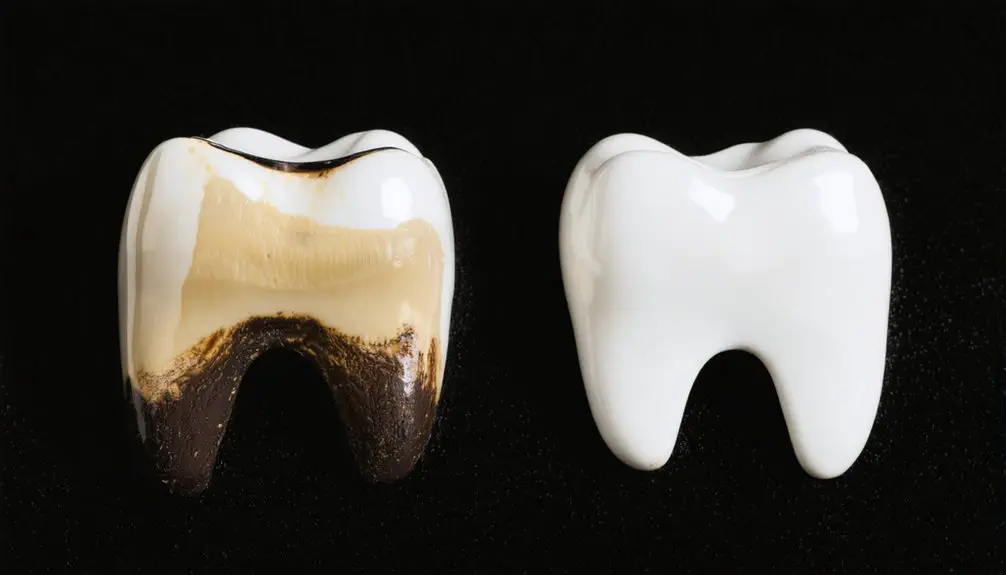
To preserve your newly whitened smile over time, you’ll need an extensive maintenance strategy that combines proper oral hygiene, professional care, and lifestyle modifications.
Brush twice daily with a soft-bristled toothbrush and ADA-approved fluoride toothpaste, and floss regularly to prevent stain buildup. Schedule professional cleanings every six months for thorough stain removal and customized maintenance recommendations. Consider using desensitizing toothpaste to alleviate any post-whitening discomfort. If you experience dental sensitivity, notify your dentist immediately to adjust your maintenance routine. Consume crunchy fresh produce to help maintain natural enamel protection.
For best results, perform periodic touch-up treatments as directed by your dental professional, but avoid overuse of whitening products.
Use a straw when drinking staining beverages, and rinse your mouth immediately after consuming foods that could discolor teeth. Replace your toothbrush every 2-3 months to guarantee effective cleaning without damaging your enamel.
Frequently Asked Questions
How Long Should I Wait Between Whitening Treatments for Smokers’ Teeth?
While teeth sensitivity’s a concern, you’ll need 6-12 months between professional treatments and 3-6 months for at-home kits. If you smoke, maintain these treatment intervals to protect your enamel.
Can Electronic Cigarettes Cause the Same Level of Teeth Staining?
No, e-cigarettes cause less teeth staining than traditional cigarettes, though nicotine effects still yellow your teeth. You’ll see visible staining from vaping, but it’s typically milder than smoking’s impact.
Will Whitening Treatments Affect Existing Dental Work Like Crowns or Veneers?
Like armor against change, your dental work won’t respond to whitening effects. Your crowns, veneers, and fillings will maintain their original shade while your natural teeth lighten from treatment.
Does Secondhand Smoke Exposure Cause Noticeable Teeth Discoloration?
Yes, secondhand smoke can cause noticeable teeth discoloration. You’ll see yellowing and staining as nicotine and tar from ambient smoke penetrate your tooth enamel, though typically less severe than direct smoking.
Are There Natural Remedies That Effectively Remove Tobacco Stains?
You can mix baking soda with hydrogen peroxide to create a whitening paste. This natural remedy helps break down tobacco stains, but you’ll need to use it moderately to protect your tooth enamel.
References
- https://healthylifedentalcare.com/best-teeth-whitening-for-smokers/
- https://tooth-doctor.com/teeth-whitening-can-remove-smoking-stains-fact-or/
- https://www.natrusmile.com/blogs/news/teeth-whitening-for-smokers
- https://www.goodhousekeeping.com/health-products/g28723133/best-at-home-teeth-whitening-products/
- https://starwhitedental.com/blog/the-best-teeth-whitening-treatment-for-smokers-and-coffee-drinkers/
- https://rontostodds.com/blog/teeth-whitening-for-smokers-addressing-stains-from-tobacco-use/
- https://www.greentreedentalgroup.com/articles/tobacco-stains-on-teeth-a-comprehensive-guide
- https://pmc.ncbi.nlm.nih.gov/articles/PMC9932248/
- https://legacydental.com/blog/intrinsic-tooth-stains-causes-treatments/
- https://www.frontiersin.org/journals/pharmacology/articles/10.3389/fphar.2023.1161728/full
